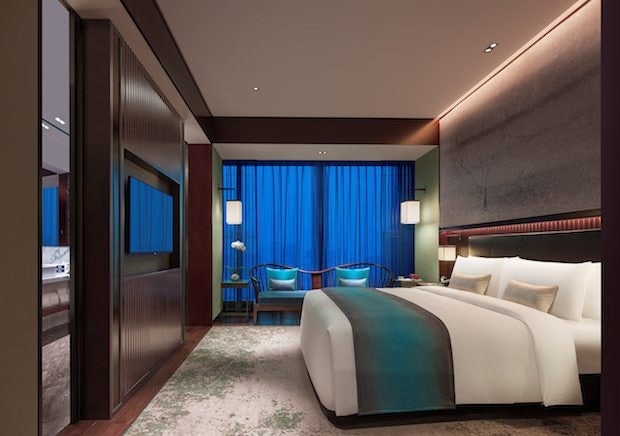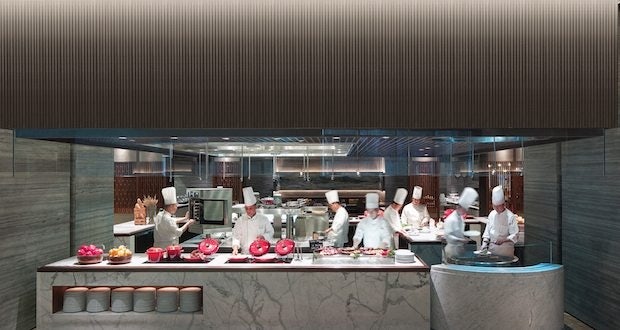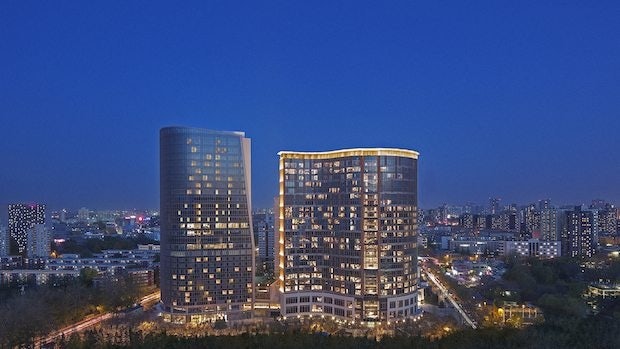
Zeng Fanzhi's 2.5-ton silver and bronze sculpture Le Shan in the lobby of the NUO Hotel Beijing. (Courtesy Photo)
Renowned Chinese artist Zeng Fanzhi, Kempinski Hotels, and a host of culture and design experts are helping a state-owned tourism company give the “Chinese Dream” an ultra-luxury image with NUO, a new Chinese hotelier with big global ambitions.
With a Chinese name that means “Golden Promise” (Nuo Jin), the artistically inclined hotel brand has a self-proclaimed mission to “build a Chinese national brand" and "forge an international path,” while calling itself a symbol of the “Chinese Dream.” Owned entirely by the massive state-run leisure and travel services company Beijing Tourism Group, NUO focuses on four branding “pillars” called “Contemporary,” “Chinese,” “Luxury,” and “Green,” which are all on full display at its palatial first location that opened in June this year near Beijing’s Art District 798.
With branding undertaken by German luxury hotelier Kempinski and French consultancy Landor in consultation with Chinese historians and design experts, the Beijing location can be thought of as a modern interpretation of a Ming dynasty scholar’s studio—albeit a much more opulent version. “We have moon gate-shaped doors, the furniture is Ming design; the style, the pattern is from Ming design as well,” says NUO Beijing General Manager Adrian Rudin.
The “Contemporary” aspect of the hotel brand’s theme refers to its extensive collection of Chinese contemporary art. The value of the Beijing location’s art is estimated to be around US$50 million and was produced and curated with the help of Zeng, the hotel’s honorary art consultant, who currently holds the record for the most expensive Chinese painting ever sold at auction.
Zeng’s influence is felt immediately upon entering the lobby, which features his 2.5-ton silver and bronze sculpture entitled Le Shan, as well as an oil painting by him entitled Landscape 2014. Zeng paintings will also be found in the hotel’s Presidential Suite, while every room in the hotel features an original print wall mural, some with the artist’s signature. The artist was also tasked with selecting works by a group of 13 up-and-coming Chinese contemporary artists that can be found throughout the hotel.

The hotel's rooms feature original prints by Zeng Fanzhi. (Courtesy Photo)
The prominence of contemporary art in the hotel follows the trend of a number of “art hotels” popping up across Beijing, including the East Hotel, the Opposite House, and Hotel Éclat. According to Rudin, the trend is due to the fact that Beijing has taken shape as China’s art hub. “I think it has a lot to do with the capital. You look at the Art District 798, which is next door to us, and I think the contemporary art movement sort of happened in Beijing in consolidated form in the 90s.”
The contemporary art is one aspect of the hotel’s goal to showcase the best of Chinese culture. Zeng’s Le Shan is intended to be a homage to an essay by Ming dynasty scholar Zhang Dai. Representing the hotel’s “Chinese” branding pillar, the Ming dynasty influenced every aesthetic detail of the property, with each area based on a historical “muse” from the era. Rooms are laid out and decorated with inspiration from Ming dynasty literary figure Wen Zhenheng, and include traditional tea sets and classical Ming-era poetry carved into the wall above the bathtubs meant for contemplation. In addition to a Ming-style Chinese restaurant, the hotel also features a traditional Chinese tea house, as well as a buffet restaurant inspired by Ming dynasty admiral Zheng He featuring cuisines from the various countries he visited on his naval expeditions.

The Zheng He-inspired dining area at NUO Hotel Beijing. (Courtesy Photo)
The Ming dynasty focus is exclusive to the Beijing location, and future hotels in other Chinese cities will reflect the heritage of where they’re located, says Rudin. “Wherever we go within China, we use the significance or the importance of the dynasty relevant to the city.” For example, a Xi’an hotel would be influenced by the Tang dynasty, while a Hangzhou location would be focused on the Song. While these are in the conceptual stages right now, the hotel brand has another location planned to be opened in conjunction with Beijing’s Universal Studios that will be in the style of the city’s Old Summer Palace that was destroyed by the British during the Second Opium War of 1860.
Despite China’s rampant pollution problems, the hotel wants environmental sustainability to be a part of its Chinese identity with a strong focus on its “Green” pillar. The Beijing location is LEED-certified with a German-designed energy-saving system and an environmentally friendly laundry system. To ward off Beijing’s toxic air, it features a built-in air purification system that has received European medical-grade classification.

An exterior view of the NUO Hotel Beijing. (Courtesy Photo)
But China is not the main focus of the brand for the long-term. “The brand was actually designed to venture outside of China,” says Rudin. “We don’t want to compete in China; we actually want to go outside of China pretty quickly,” he states, noting that the company is eyeing locations in Dubai, Bangkok, and Europe. While he expects the guest breakdown to be about 70 percent Chinese and 30 percent foreign at the Beijing location, Rudin predicts that future international locations will be a "50/50" mix of Chinese travelers and others.
In order to market the hotel abroad, the state-owned brand will have to convince sophisticated travelers around the world that five-star “Made-in-China” luxury can impress the most discerning tastes. To meet this goal, the hotel brand has incorporated amenities such as round-the-clock butler service, all-marble bathrooms, rainfall shower heads, flat-screen high-definition televisions, Bluetooth-enabled Bose stereo speakers, and custom Pu’er tea-infused bed and bath accessories created by luxury skincare brand Ba Yan Ka La.
The company’s ambitious expansion plan is to have 15 hotels in China and globally within the next 10 to 15 years, and its management is confident that its global vision of Chinese luxury will catch on across the world. According to Rudin, “Western brands bring Western culture into China, and the idea is to bring Chinese culture to Western countries. That’s the whole concept.”